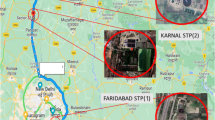Abstract
Dewatered sludges from twenty-two sewage treatment facilities were characterized to develop the quality control indices in India. This study used fertilizer index (FI) and clean index (CI) as a tool for categorizing sludge utilization into different classes (A, B, C and limited use classes LU-1, LU-2, LU-3) by their fertilizing potential, toxicity level, pathogen presence, and vector attraction reduction criteria. The findings revealed that total P (as P2O5), total N, and K (as K2O) in the sludge samples ranged from 0.9 to 5.7%, 1.2 to 3.8%, and 0.1 to 1.5%, respectively. Moreover, all sludges belong to Class C and lower category due to the presence of toxic metals and pathogens. The helminth eggs were found in the range of 25–1450 Numbers/4gTS in sludge samples. The highest number of helminth eggs of 1450/4 g of TS was found in the fecal sludge. The specific oxygen uptake rate (SOUR) values in the sludge samples varied from 0.3 to 4.9, with a median value of 1.3 and an RSD of 86% is way too high. It indicates that the sludge samples need further treatment to be less attractive as a food source for vectors and rodents. However, sludge samples have fertilizing potential and FI values ranges from 4.1 to 4.9, and CI value ranges from 2.5 to 5.0. It indicates that compost is best in quality and has high-fertilizer potential and low heavy-metal content, which is suitable for high-value crops such as organic farming. Further sludge treatment using typical composting, aerobic or anaerobic digestion, and solar or thermal drying could bring the sludges into the Class A and B categories.
Graphical abstract




Similar content being viewed by others
Data availability
Not applicable.
References
Antonkiewicz J, Kołodziej B, Bielińska EJ, Gleń-Karolczyk K (2018) The use of macroelements from municipal sewage sludge by the Multiflora rose and the Virginia fanpetals. J Ecol Eng 19(6):1–13. https://doi.org/10.12911/22998993/92889
Antonkiewicz J, Kołodziej B, Bielińska EJ, Popławska A (2019) The possibility of using sewage sludge for energy crop cultivation exemplified by reed canary grass and giant miscanthus. Soil Sci Annu 70(1):21–33. https://doi.org/10.2478/ssa-2019-0003
APHA (2017) Standard methods for the examination of water and wastewater, 23rd ed. American Public Health Association (APHA), Washington, DC.
Briton WF (2000) Compost quality standards and guidelines. Final Report. Woods End Research Laboratory, Inc., USA. < http://Compost.Css.Cornell.Edu/Brinton.Pdf
Cohen Y (2009) Phosphorus dissolution from ash of incinerated sewage sludge and animal carcasses using sulphuric acid. Environ Technol 30:1215–1226
CPHEEO (2016), Indian standard methods of Analysis of solid wastes. Central Public Health and Environmental Engineering Organisation IS-10158, 1982 (Reaffirmed 2003)
Ehalt MacEdo H, Lehner B, Nicell J, Grill G, Li J, Limtong A, Shakya R (2022) Distribution and characteristics of wastewater treatment plants within the global river network. Earth Syst Sci Data 14:559–577
FCO (2009) Fertiliser (Control) Order 1985. The Fertiliser Association of India, Ministry of Agriculture and Rural Development, India. 10, Shaheed Jit Singh Marg, New Delhi, India
GTZ Sustainet (2006) Sustainable agriculture: a pathway out of poverty for India’s rural poor. Deutsche Gesellschaft für Technische Zusammenarbeit, Eschborn
Gurjar BR, Tyagi VK (2017) Sludge management. Taylor & Francis, United Kingdom
Indian standards (1982) Methods of Analysis for solid wastes (IS 10158)
Larson DW, Jones E, Pannu RS, Sheokand RS (2004) Instability in Indian agriculture—a challenge to the green revolution technology. Food Policy 29(3):257–273
Lotter DW, Seidel R, Liebhardt W (2003) The performance of organic and conventional cropping systems in an extreme climate year. Am J Altern Agric 18(3):146–154
Metcalf & Eddy (2003) Wastewater engineering: treatment and reuse. McGraw Hill, USA
Saha JK, Panwar N, Singh MV (2010) An assessment of municipal solid waste compost quality produced in different cities of India in the perspective of developing quality control indices. Waste Manag. 30:192–201
Singh V, Harish PC, Chandel MK (2020) Estimation of energy recovery potential of sewage sludge in India: waste to watt approach. J Clean Product 276:122538
Soumaré M, Tack FMG, Verloo MG (2003) Characterisation of Malian and Belgian solid waste composts with respect to fertility and suitability for land application. Waste Manag 23(6):517–522
Tyagi VK, Lo SL (2013) Sludge: a waste or renewable source for energy and resources recovery? Renew Sustain Energy Rev 25:708–728
USEPA (1979) Process design manual for sludge treatment and disposal. EPA 625/1–79/011
USEPA (1982) Guide to the disposal of chemically stabilized and solidified waste, SW-872, Washington, DC, Office Solid Waste Emergency Response
USEPA (1992) Integrated risk information system- molybdenum; CASRN 7439–98–7
USEPA (1994) Standards for the use or disposal of sewage sludge (40 CFR Part 503). A Plain English Guide to the EPA Part 503 Biosolids Rule
USEPA (1999) Environmental regulations and technology—control of pathogens and vectors in sewage sludge. EPA-625/R-92/013 (Revised October 1999)
WHO (1996) Analysis of wastewater for use in agriculture – a laboratory manual of parasitological and bacteriological techniques
Funding
The authors are thankful to the National Mission for Clean Ganga (NMCG), Central Pollution Control Board, CPCB [Grant No. PJ-14012 (11)/1/2021-WQM-II-HO-CPCB], the Department of Biotechnology (Grant No. BT/RLF/Re-entry/12/2016), and the Department of Science and Technology (Grant No. DST/IMRCD/India-EU/Water Call 2/ SARASWATI 2.0/2018/C), Government of India, for financial support for this research.
Author information
Authors and Affiliations
Contributions
Ganesh Sude: conceptualization, visualization, methodology, writing – original draft, data curation. Ankur Rajpal: conceptualization, visualization, methodology, writing – original draft, data curation. Vinay Kumar Tyagi: conceptualization, visualization, resources, methodology, writing – review and editing, critical suggestions, supervision. Kapil Sharma: writing – original draft, data curation. Pravin Kumar Mutiyar: writing – review and editing, critical suggestions. B.K. Panday: writing – review and editing, critical suggestions. R.P. Pandey: writing – review and editing, critical suggestions. Absar Ahmad Kazmi: conceptualization, visualization, resources, writing – review and editing, critical suggestions, supervision.
Corresponding author
Ethics declarations
Ethical approval
Not applicable.
Consent to participate
Not applicable.
Consent for publication
Not applicable
Competing interests
The authors declare no competing interests.
Additional information
Responsible Editor: Guilherme L. Dotto
Publisher's note
Springer Nature remains neutral with regard to jurisdictional claims in published maps and institutional affiliations.
Rights and permissions
Springer Nature or its licensor (e.g. a society or other partner) holds exclusive rights to this article under a publishing agreement with the author(s) or other rightsholder(s); author self-archiving of the accepted manuscript version of this article is solely governed by the terms of such publishing agreement and applicable law.
About this article
Cite this article
Sude, G., Rajpal, A., Tyagi, V.K. et al. Evaluation of sludge quality in Indian sewage treatment plants to develop quality control indices. Environ Sci Pollut Res 31, 17578–17590 (2024). https://doi.org/10.1007/s11356-023-25320-1
Received:
Accepted:
Published:
Issue Date:
DOI: https://doi.org/10.1007/s11356-023-25320-1




